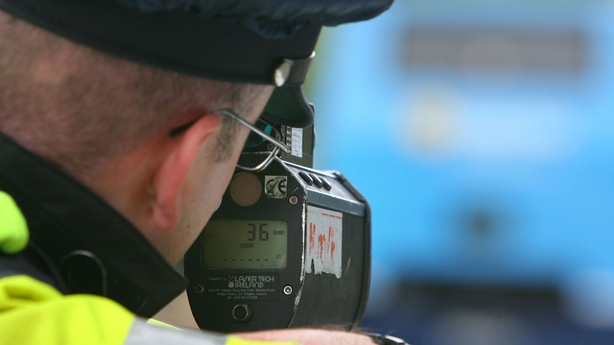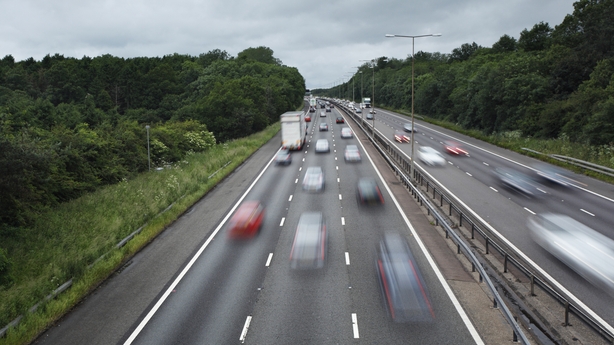A motorist was detected travelling at 194km/h in a 100km/h zone on the N25 in Cork today during National Slow Down Day.
National Slow Down Day is aimed at reminding drivers of the dangers of speeding.
The garda operation also aims to increase compliance with speed limits and is in effect from 7am this morning until 7am tomorrow.
Gardaí said that in the first ten hours of the 'Slow Down Day', the speeds of over 115,000 vehicles were checked and 174 were caught speeding.
In Donegal, a motorist was clocked at 132km/h in a 100km/h zone on the N13 near Stranorlar, while GoSafe also detected a driver travelling at 127km/h in a 100km/h zone on the N13 at Letterkenny.
Elsewhere, a motorist was detected driving at 109km/h in an 80km/h zone on the R314 at Ballina in Mayo.
In Meath, a driver was caught driving at 108km/h in an 80km/h zone on the R158 near Trim.
In Wexford, a vehicle was detected travelling at 102km/h in an 80km/h zone on the R772 near Enniscorthy, while another driver was caught driving at 95km/h on the same stretch of road.
In Dublin, a motorist was clocked at 69km/h in a 50km/h zone on the James Larkin Road in Raheny and on the Swords Road a driver was clocked at 87km/h in a 50km/h zone.
Meanwhile, another motorist was caught travelling at 84km/h in a 60km/h zone on the R139 near Belcamp in the capital.
GoSafe clocked a motorist in Limerick at 121km/h in a 100km/h zone on the N21 near Rineroe, Adare, while another was detected driving at 78km/h in a 50km/h on the N84 at Cloonboo, Co Galway.

It comes as gardaí are calling on motorists to support today's 24-hour nationwide operation targeting speed to make Irish roads safer for all users.
Just four months into 2024, already 63 people have been killed on roads in Ireland. That is 14 more lives lost than on this same day last year.
Today's initiative, which is supported by the Road Safety Authority (RSA), is to promote safer driving behaviour among motorists and to encourage all of society to help prevent road traffic collisions.
It is being run in conjunction with other European jurisdictions to encourage drivers to lower their speed, Supt Liam Geraghty has said.
Earlier, gardaí said that in the first two hours of the 'Slow Down Day', the speeds of over 16,300 vehicles were checked and 21 were caught speeding.
Among the vehicles caught speeding was one travelling at 109km/h in a 80km/h zone in Ballina, Co Mayo.
Another driver was caught travelling at 132km/h in a 100km/h area in Stranorlar, Co Donegal.
Speaking on RTÉ’s Morning Ireland, Supt Geraghty said gardaí are asking people to drive at the appropriate speed for the road and traffic conditions.
"The call today is the same as it is everyday," he said.
"We've seen too many fatalities on our roads last year and again so far this year. Thankfully, in the last week, or a little bit longer, we haven't had a fatal road traffic collision on our roads, but we are still seeing serious road traffic collisions taking place.
"Unfortunately, the trend is going in the wrong direction."

Today's garda operation will centre on high visibility speed enforcement activity across Ireland’s road network.
Supt Geraghty added: "Every day, it is a serious responsibility when you go out in a vehicle and are driving on our roads. We call on everybody to make our roads a safer place every day."
In relation to the directive for gardaí to carry out 30 minutes of high visibility roads policing on each shift, Supt Geraghty said the Garda Commissioner recognised the significant volume of work that frontline personnel are already contributing to road safety.
"What international experience and the Swedish model of traffic policing would show is that the presence of a police officer, a high visibility presence of a police officer, at a particular location modifies driver behaviour, not just during the period of that presence, but for a significant period after the presence of that police officer for up to a number of hours."
Supt Geraghty said that the 30 minutes is not at the expense of other duties.
"The instruction to gardaí is to find 30 minutes where they are highly visible at a particular location or a particular area to encourage modification of people's use of the roads in that area at that time, which will then have a longer lasting effect."
